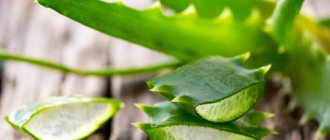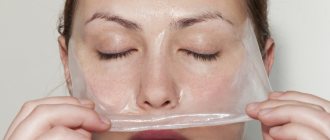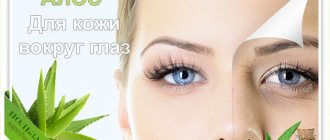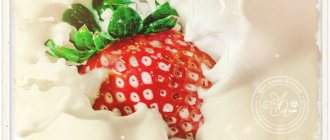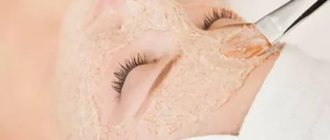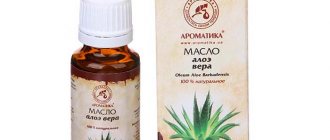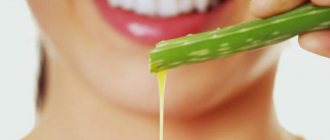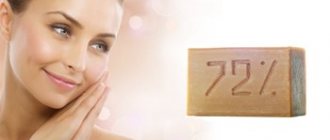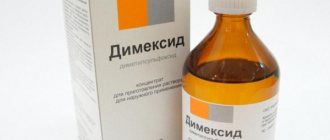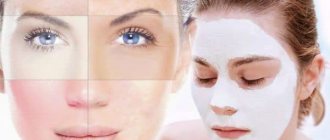Even in Ayurveda books there is a mention of this wonderful plant. Its healing properties are widely used to treat skin diseases.
Aloe was first used more than 5,000 years ago in ancient Egypt. In recent years, its use has become very popular in cosmetology, pharmaceuticals and food.
The inner mucous tissue of the leaves is used. It is 96% filled with water. Together it has the consistency of a gel, which is what makes this plant so valuable due to its vitamins, minerals, amino acids and antioxidants.
Next, you will learn how this elixir helps maintain youthful and clear skin. In addition, I offer several excellent recipes using plant juice.
Features of the plant
In Latin this plant is called aloe barbadensis miller. It is from the family of lilies, cacti, and succulents. Aloe grows in the desert regions of the African, Eurasian, North and South American continents.
It is unique in its range of bioactivity - from effective wound healing to the destruction of many types of microbes. And most importantly, aloe vera is suitable for everyone, including allergy sufferers and those with hypersensitive skin.
Chemical composition
This foreign cactus, familiar to us since childhood, contains over 200 active substances and 70 nutrients. Among them:
- Vitamins A, C, E, B1 - B6, B12;
- Succinic, cinnamic, amino and other acids;
- At least 30 mineral elements - calcium, copper, selenium, manganese, phosphorus, iron, chromium, potassium, zinc, magnesium;
- Phytoncides, flavonoids;
- Essential oils, esters;
- Alkaloids;
- Resins and tannins.
There is another wonderful ingredient in aloe vera, for which cosmetology adores it - allantoin. It is a conductor of benefits: it penetrates into the deep layers of the skin and “brings” other healing substances there.
Another value of agave in the eyes of doctors and cosmetologists is polysaccharides. It is thanks to them that the plant has a pronounced moisturizing effect. The invisible polysaccharide coating literally attracts water and prevents it from evaporating, dehydrating the cells.
Deep moisturizing procedure
On women's forums you can find another interesting recipe with aloe and fruits, which is designed to intensively moisturize aging skin.
How it's done:
- prepare the pulp of any fruit, it is important that it is ripe;
- gently wipe your face with it to open the pores;
- wait 5 minutes and wash;
- mix aloe vera juice (15 ml) and lavender or jasmine essential oil (2 drops);
- use a cotton pad for application (the drier the skin, the more layers);
- rinse off the product after 10-15 minutes;
- Apply moisturizing cream to your face.
How aloe is good for facial skin
Of course, if the cause of your skin problems, for example, is in the internal organs, the first thing you need to do is cure them. But even then the plant will significantly speed up recovery. All its qualities cannot be counted: antiviral, antifungal, restorative at the cellular level. What agave can do for the face:
Nutrition and hydrobalance
Despite its rich composition, more than 95% of aloe gel is water. Thanks to this, the hydration is enormous, but without the feeling of stickiness or greasy. The absence of a sticky effect does not interfere with the gluing of the upper cells of the dermis, which helps to smooth and soften them. It also retains moisture extremely effectively.
Tissue healing
The notorious polysaccharides stimulate the growth of new cells and actively restore damaged tissue. Carboxypeptidase is an element that perfectly relieves pain. It is also found in aloe vera. Therefore, the juice of the plant is good to use for skin burns of any origin and mechanical damage to tissues.
Inflammation
Many skin problems involve redness, itching, irritation and pain. Agave gel contains acemannan, a substance that can suppress inflammatory processes. Before treating inflammation, test the agave extract on another area of the skin: depending on the cause of your illness, the reaction may be different, even allergic dermatitis.
Pimples
Aloe vera can replace a dozen cosmetic products for various skin imperfections. Thanks to salicylic acid in the composition, it cleanses pores and regulates sebum production. Acne responds well to treatment due to its anti-inflammatory and antimicrobial effects. In addition, the properties of the plant gradually help to dissolve scars and dark circles left from acne of any kind.
Herpes
This antiseptic plant not only stops fungus and microbes due to phenols, sulfur, and salicylic acid in the composition. Aloe helps the immune system produce antibodies to destroy the herpes virus. At the same time, the effects of the virus heal without leaving traces.
Age-related changes
Charges fibroblasts with energy, thereby activating the production of collagen and elastin. This makes the dermis elastic, smooth, elastic. The astringent properties of zinc narrow enlarged pores, and vitamins C and E (detoxifiers) act as a preventative against the accumulation of free radicals.
Dark spots
Aloe vera juice launches a complex mechanism to combat the aging of the epidermis. Reduces the activity of tyrosinase, an enzyme that is responsible for the color of the skin. This helps inhibit hyperpigmentation caused by UV radiation. It also hardens the skin from the effects of sunburn.
Scrubbing
Multifunctional salicylic acid gently exfoliates dead cells. And lignin - another miracle substance in the composition of agave - promotes deep penetration into the dermis.
Interesting: How to do facial peeling with salicylic acid in a salon or at home.
What should be the result?
After just a few uses of this folk remedy, a feeling of softness and velvety appears, the skin tone is evened out, inflammatory processes disappear, the water balance is normalized, and there is a feeling that the skin is “breathing.”
The procedure has a regenerating effect and helps restore the epidermal layer.
How to properly prepare aloe juice
We take the widest, fleshiest leaves of the plant - they are located at the bottom of the trunk. The most useful of them are those whose ends have begun to dry out. In such leaves, the concentration of these substances is at its maximum.
Important: cut agave leaves should not be stored in the light, as this will cause their beneficial properties to disappear.
If you have time, prepare the most useful version of the vegetable squeeze. To do this, cut leaves are kept in the refrigerator for a week to 12 days at minus 5-8 degrees. Then rinse with cooled boiled water. The pulp is taken out with a spoon or knife, squeezed out, and filtered through a multi-layer bandage. The resulting liquid is boiled over low heat for 2-3 minutes.
Some people recommend using the peel of the leaves along with the pulp. Be extremely careful: when chopping the peel, you may not notice the prickly thorns.
Tricks for preparing agave leaves
To make the most of all the beneficial elements, you need to properly prepare the leaves for use. Only the lower leaves of the plant should be selected. It takes place in several stages:
- Cut off the lower leaves and wash with boiled water.
- Wrap in paper and put in the refrigerator. It is recommended to wait about one and a half to two weeks, but less is possible.
- The prepared product is crushed in a blender, meat grinder or grated on a fine grater, and then the juice is squeezed out of the pulp.
- The juice should be filtered using thick material or gauze.
It is recommended to use immediately, because after storage the beneficial substances lose their activity.
Pure facial juice
This is a wonderful example of a universal product - that is, suitable for all skin types. The juice cleanses oily skin, nourishes dry skin and protects extremely sensitive skin. The face is transformed, acquires a healthy glow from the inside, and rejuvenates. The skin looks and feels noticeably more toned, elastic, and able to withstand natural age-related changes.
Anti-wrinkle lotion
A couple of the largest leaves are mixed with a liter of cold boiled water. Bringing the mixture to a boil, keep it on low heat for another 5 minutes. Then cool and filter. The lotion is stored in glass in the refrigerator.
Wipe lotion
You don’t have to bother with preparations; this will not make aloe juice any less effective. Keep it pure and use it twice a day after washing your face, wiping your face with a cotton pad.
Cosmetic ice
2-3 tablespoons of agave juice are mixed with 100 ml of sage infusion. This mixture is poured into ice molds. You need to wipe your face with ice cubes every day. You tone the skin and help it fight acne.
Indications
Aloe extract has a wide spectrum of action.
INDICATIONS
- inflammatory processes on the epidermis (acne, eczema, psoriasis, dermatitis: seborrheic, atopic, allergic);
- uneven skin tone (pigment spots, redness);
- dryness, peeling;
- excessive secretion of sebum;
- age-related changes in the skin (decreased tightness, elasticity, sagging, wrinkles, creases);
- violation of the integrity of the epidermis (wounds, burns, abrasions).
The extract is also indicated for preventing skin problems and maintaining a healthy appearance.
Aloe boasts an anti-inflammatory effect. That is why it will be relevant for acne. Apply the product directly to pimples with a cotton swab three times a day.
Dermatologist Emily Altman
Aloe gel in its pure form
The aging process can slow down aloe vera leaves from 3 years of age. Therefore, it is better to leave the “young animals” to ripen; they do not have a particular concentration of benefits.
To use aloe gel, keep the cut leaves in a cool place without light for one to two weeks (for example, on the “warmest” shelf of the refrigerator, at the bottom). If time is of the essence, wait longer. It turns out that the bioactivity in cut leaves is much higher, which means the quality of aloe properties increases significantly.
How to extract the gel correctly
It may seem simple, but doing it right will ensure maximum benefit.
- Cut off the leaves at the very base. The outer leaves are preferable - they are more “ripe” and there is much more fresh gel in them. One or two sheets will yield one and a half to two cups of gel. This product spoils quite quickly, so don't make too much at once.
- We wash the leaves under the tap. This is mandatory: so that invisible dirt and microorganisms from the surface of the leaf do not get on the skin.
- Place the leaves in a cup in a vertical position. We wait about 10 minutes until the light brown liquid—resin—flows out. It contains latex, which can cause irritation.
- Cut off the skin from the flat side and use a spoon to remove the “meat” of the leaf.
If you do not plan to use the pulp now, store it in ice-cold molds in the refrigerator. Unfrozen, it will last a couple of weeks at most.
To keep the gel for 30 days or longer, mix every quarter cup of aloe pulp with 500 mg of vitamin C powder or a couple of drops of vitamin E in oil - these are natural preservatives. This mixture needs to be scrolled in a blender.
How to use aloe gel
The first rule with anything your body comes into contact with is to make sure it is safe for allergies. How to apply the gel:
- We blot the cleansed facial skin with a napkin;
- With clean hands, apply a thin layer of gel;
- Leave for a few minutes to absorb. But no more than 10, so as not to cause a feeling of tightness;
- Rinse off with cool water and finish with your usual cream to nourish or moisturize the skin.
The frequency of the procedure is daily, in the morning or before going to bed.
Aloe Vera Lotions
Fading skin. Cut 2 fleshy aloe leaves, add water. Bring to a boil, cook for 7 minutes over low heat. Let cool and strain.
Dry skin and whitening. Mix grated cucumber and aloe in equal proportions along with the peel (remember the thorns). Dilute with your favorite base oil - olive, wheat germ, almond or sunflower. Beat the mixture with a blender, strain and pour in the same amount of boiled water.
Invigorating effect. Agave juice, a few balls of vitamin E in oil, a little tea (preferably herbal) and a couple of drops of mint oil very refresh not only the skin of the face, but also the thoughts.
Problem skin. Alcohol or regular vodka is mixed with aloe juice in a ratio of 1 to 4.
Inflammation-prone skin. A decoction of sage and plantain is mixed with rose water and aloe juice. The lotion copes well with clearly protruding capillaries.
In addition to lotion, you can prepare a tonic. The principle is the same, only the concentrated ingredients need to be diluted with even more liquid.
Ideally, take not water, but infusions or fresh decoctions of various herbs, as well as herbal teas.
Pharmacy products: advantages and disadvantages, application
There is a large selection of pharmaceutical products with aloe , but you need to keep in mind that many of them contain preservatives and, of course, cannot be compared with the natural juice of the plant.
Let's consider one of them, because as the manufacturer itself, the Korean brand Holika Holika, states, this product contains 99% aloe juice.
This gel:
- Suitable for any skin type (moisturizes dry skin, dries out oily skin);
- perfectly absorbed;
- ideal for sensitive and blemish-prone skin;
- helps reduce irritation;
- Moreover, it can be used as a base for makeup.
The gel is used not only for the face, but also for the body, hair and skin around the eyes. The first results appear within a week after application.
Disadvantage: runs out quickly!
- For daily hydration, apply a thin layer to clean, dry skin. Do not wash off!
- A moisturizing mask should be done 2-3 times a week; to do this, apply the gel in a very thick layer on the face and leave for half an hour, remove the excess with a napkin.
Who is not suitable for aloe vera?
Individual intolerance to aloe is a rare thing, but it does exist. Contraindications for oral use of agave:
- Gallbladder and liver diseases;
- Diseases that involve the possibility of bleeding (uterine, stomach, hemorrhoids);
- Cystitis;
- Inflammation of the gastrointestinal tract.
Also, do not apply aloe juice (especially in its pure form) to skin with pronounced vascular cobwebs.
Check all components of masks for individual tolerance, especially if you have very sensitive skin. There are many recipes, you can invent them yourself. Therefore, if you doubt the composition, do not take risks - look for another option.
pharmachologic effect
Pharmacological action - general tonic, adaptogenic.
Aloe juice enhances bile secretion, the secretion of digestive glands, has a laxative effect and bactericidal activity against pathogens (internally), anti-inflammatory, wound-healing effect (externally).
Aloe syrup with iron contains easily digestible iron for the formation of hemoglobin and normal hematopoiesis, replenishes the lack of iron in the body associated with poor absorption in the gastrointestinal tract, blood loss, malnutrition, increased need for iron (pregnancy, active growth in children and adolescents).
Aloe liniment accelerates epithelization, increases skin tolerance to X-ray irradiation, has an analgesic effect, reduces burning sensation and tightness. In experiments on rabbits, it was found that when used prophylactically, it reduces the reaction and significantly shortens the healing time of radiation damage to the skin.
Aloe coated tablets are used as a biogenic stimulant.
